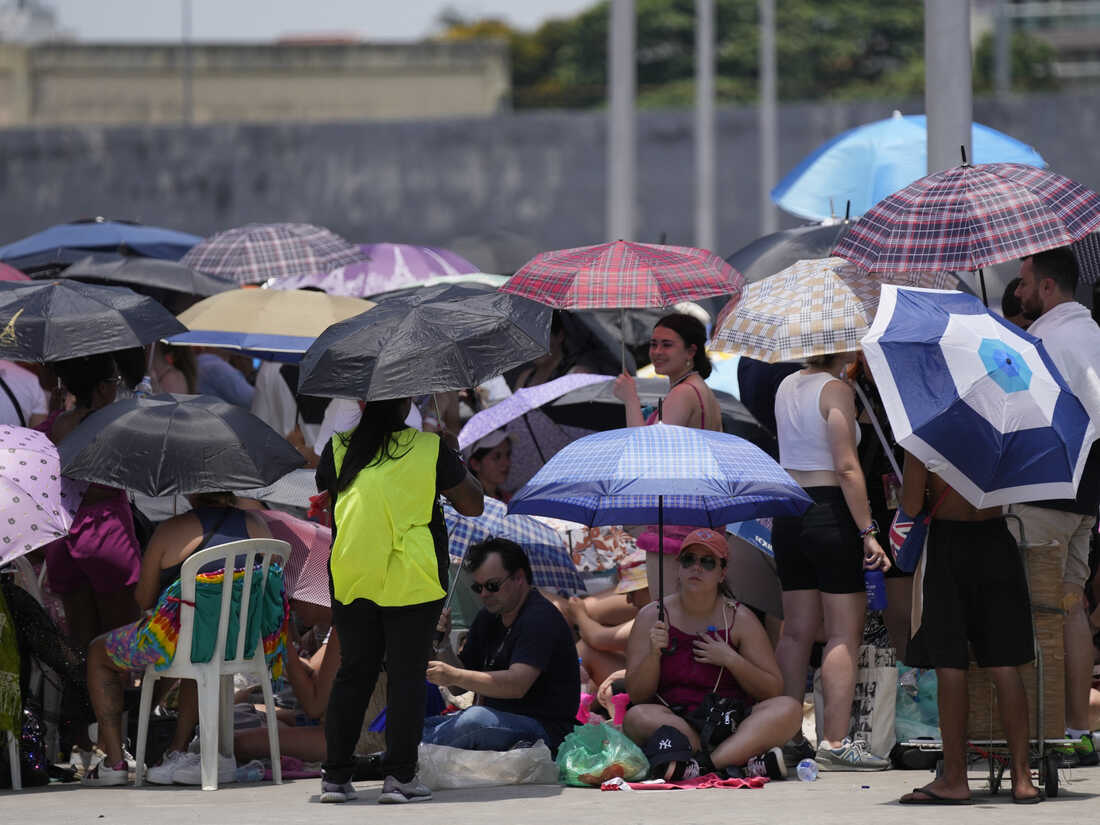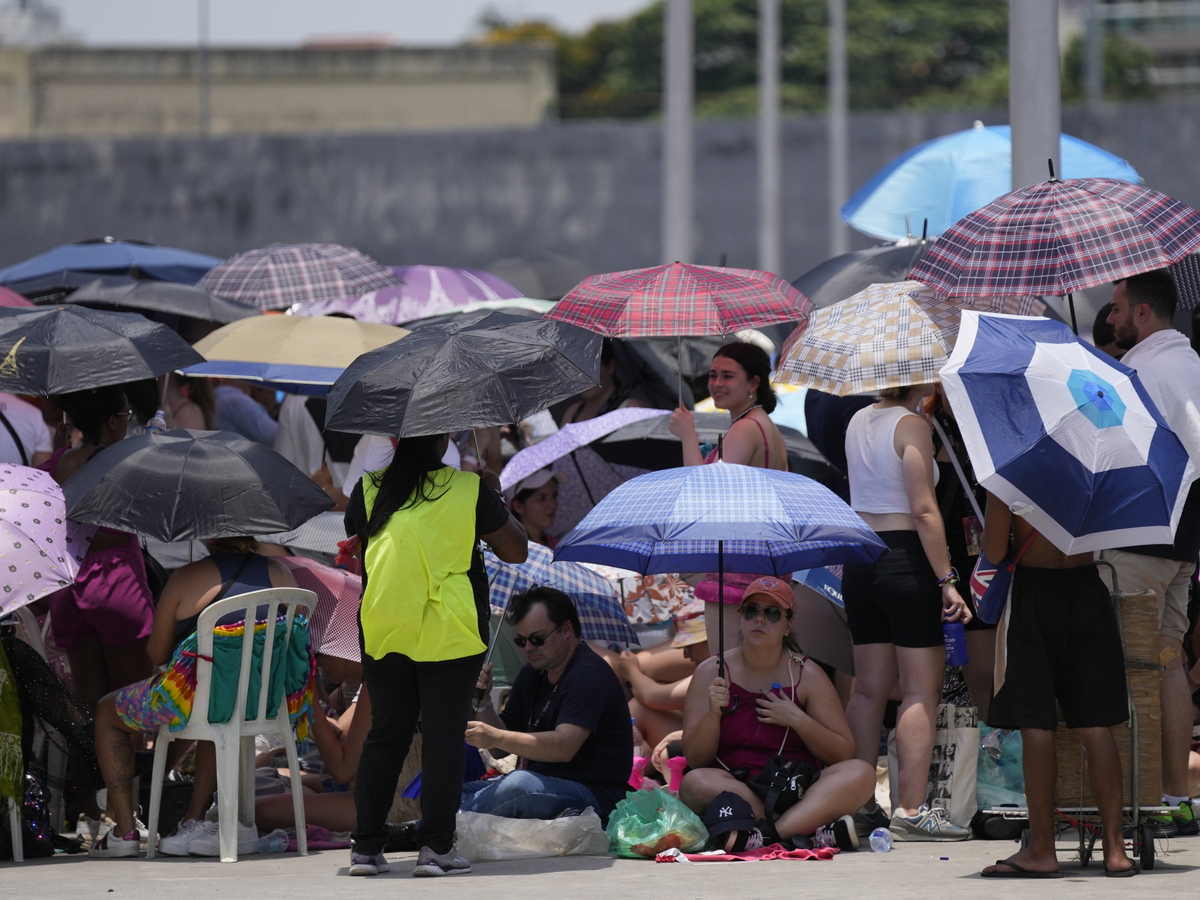
[ad_1]

Taylor Swift followers anticipate the doorways of Nilton Santos Olympic stadium to open for her Eras Tour live performance amid a warmth wave in Rio de Janeiro, Brazil, Saturday, Nov. 18, 2023. A 23-year-old Taylor Swift fan died Friday evening after affected by cardiac arrest attributable to warmth on the live performance, in response to an announcement from the present’s organizers in Brazil.
Silvia Izquierdo/AP
disguise caption
toggle caption
Silvia Izquierdo/AP

Taylor Swift followers anticipate the doorways of Nilton Santos Olympic stadium to open for her Eras Tour live performance amid a warmth wave in Rio de Janeiro, Brazil, Saturday, Nov. 18, 2023. A 23-year-old Taylor Swift fan died Friday evening after affected by cardiac arrest attributable to warmth on the live performance, in response to an announcement from the present’s organizers in Brazil.
Silvia Izquierdo/AP
Springtime is underway within the southern Hemisphere, however throughout a lot of South America it has felt just like the depths of summer time for months already. A string of warmth waves have settled in over the area, pushing temperatures into record-breaking territory month after month.
Final week, temperatures soared in southern Brazil. In Rio de Janeiro, a metropolis of almost 12 million folks, intense warmth and humidity pushed a 23-year-old Brazilian college pupil into cardiac arrest at a Taylor Swift live performance. Followers had stood in line for the Eras Tour on the Nilton Santos Olympic stadium in brutally scorching, humid, windless circumstances for hours earlier than the Friday evening present. It was simply as scorching and steamy contained in the venue, concertgoers reported.
The girl who died, Ana Clara Benevides Machado, bought medical consideration from paramedics on the live performance venue, however died later at a close-by hospital.
Rio’s temperatures final week topped 100 F. However the warmth index–a measure that takes into consideration each air temperature and humidity–made it really feel prefer it was almost 140 levels Fahrenheit. Folks can solely deal with warmth like that for just a few hours earlier than they begin to get sick–and even die.
Brazil’s Ministry of Tradition famous the acute, harmful warmth in an announcement expressing condolences for Machado’s loss of life. It is a clear sign that local weather change, the ministry mentioned, must be thought of a significant threat for occasions like huge concert events or different cultural occasions now. Swift postponed a live performance deliberate for Saturday evening, one other day that was imagined to be dangerously scorching.
Recording-breaking warmth
The warmth wave was the eighth main one of many 12 months in Brazil, says Lincoln Alves, a local weather scientist at Brazil’s Nationwide Institute for House Analysis. And it was virtually actually intensified by local weather change, says Alves. He and colleagues analyzed an analogous September warmth wave, which was at the very least 100 instances as doubtless due to local weather change.
The previous six months have every sequentially damaged regional warmth data, says Raul Cordero, a local weather scientist at Chile’s College of Santiago. “October, it was the warmest October on file. September, it was the warmest September on file. And so forth, since final Might.” He pauses, and repeats it. “Six months we’ve got seen [record-breaking heat], in a row!”
It is additional scorching throughout South America partially as a result of the area is within the throes of El Niño, which pushes temperatures up just a few levels each regionally and globally. However that warming sits on prime of long-term local weather warming, pushed primarily by the burning of fossil fuels.
“This isn’t a coincidence what is going on, not solely in Rio de Janeiro and in São Paulo in southern Brazil but in addition in Bolivia and Paraguay, and in Gran Chaco. Throughout. And a bit of additional north in Brazil, not solely are there excessive temperatures however very extreme drought,” says Cordero. “It is an enormous drawback that is affecting not solely southern Brazil however the entire subcontinent.”
Common temperatures in São Paulo have gone up by greater than 3 levels Fahrenheit because the Sixties.
A number of additional levels of warming could not sound like a lot, says Alves, however the improve within the variety of excessive warmth days has skyrocketed. Within the Sixties, there have been about seven days of significant warmth within the area–about one main warmth wave a 12 months. Now, yearly there are greater than 50 days of extraordinarily scorching climate, or about 9 main warmth occasions. That quantity is forecast to improve additional sooner or later.
How warmth kills
Air temperatures in Rio de Janeiro had been sweltering final week as concertgoers waited to get into the Nilton Santos stadium for Swift’s Eras Tour Friday evening. Folks waited for hours within the solar to get into the venue, and lots of did not have water to drink.
Excessive humidity was the opposite drawback. Folks settle down by sweating: when water evaporates, it pulls away the warmth that has constructed up within the physique. However when the air is extremely humid–in different phrases, when it is holding almost all of the water vapor it may possibly–that sweat does not evaporate. It stays beaded up on the pores and skin, ineffective.
“After we’re enthusiastic about the true huge risks to the human physique, humid warmth stress is among the greatest,” says Daniel Vecellio, a local weather scientist and warmth skilled at George Mason College. “When it begins to get actually humid, we are able to sweat as a lot as we wish to, but when that sweat cannot evaporate…that principally shuts off our most important physiological mechanism to have the ability to cool ourselves down.”
The air in Rio final week was nonetheless and stagnant making it almost inconceivable for sweat to evaporate. The air was heavy with humidity.
The physique can even settle down by shunting blood towards the tinier vessels close to the pores and skin, the place it may possibly–hopefully–come into contact with cooler air. That places stress on the guts, which must pump tougher to maneuver blood round. That is why coronary heart issues, just like the one which killed Machado, go up throughout warmth waves, says Veliccio.
It is not like folks in Brazil are unaccustomed to warmth, says Alves. “However these instances, in September, October, proper now, the temperature places an excessive amount of stress. Even these people who find themselves, I’d say, extra aware of these sorts of climates, face stress primarily based on these excessive occasions.”
Making warmth much less harmful
Warmth as all-encompassing and excessive as final week’s in Rio will all the time be harmful, says Marisol Yglesias-González, a local weather skilled on the Centro LatinoAmericano de Excelencia en Cambio Climático y Salud in Costa Rica. However warning folks upfront of maximum warmth, for instance, might help scale back the risks. Designing emergency warmth plans at venues just like the Nilton Santos stadium and different public venues is one other method to decrease dangers introduced on by scorching temperatures.
A few of the work to cut back warmth dangers can come from governments. Cities, the place huge quantities of concrete take up warmth and push temperatures up, can develop inexperienced areas or cooling facilities. Nationwide meteorological methods can ship out early warnings to assist folks plan for the worst instances, although it is essential to design efficient warnings that attain everybody they should, stresses Yglesias-González. Brazil’s meteorological company despatched out warmth warnings final week.
Efforts must occur within the personal sector, as nicely. The Brazilian Ministry of Tradition harassed in its assertion that the brand new dangers of local weather change entail coordinated efforts from occasion hosts. Emergency warmth protocols are important, says Yglesias-González. For instance, the Nilton Santos stadium prohibited concertgoers from bringing water bottles inside. That led to dehydration for a lot of followers. Brazil’s justice minister mentioned on X, previously Twitter, that water bottles can be allowed into venues sooner or later.
“They weren’t permitting folks to deliver their bottles of water into the venue? Like actually, this isn’t the 70s, we do not have the climate of the 70s! We’re dealing with an existential disaster with local weather change,” says Yglesias-González.
“If we will do some of these occasions, we’ve got to acknowledge that local weather change is a threat. And be ready for that, to guard the those who we’re bringing to see the sort of present.”
Meaning everybody, from personal firms and metropolis governments to nonprofits, wants local weather plans, she says.
Due to the continuing warmth, Swift postponed a present deliberate for Saturday. Billboard, which has begun monitoring concert events affected by climate-influenced excessive climate, has counted 30 reveals postponed or canceled to date in 2023 attributable to warmth, floods, and different climate issues.
Adapting to the warmth issues that exist, and can proceed to worsen as local weather change marches onward, is one half of the problem, says Cordero, the Chilean local weather scientist. The opposite half is tackling the basis reason behind human-driven local weather change: drastically lowering planet warming air pollution.
Swift, like different members of the richest 1% of Earth’s inhabitants, has a disproportionately excessive affect on local weather change. That group alone is answerable for about 20% of worldwide emissions, in response to a new report from Oxfam launched this week.
[ad_2]